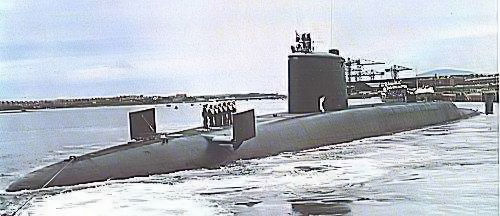About HMS Resolution
HMS Resolution (S22) was the first of the Royal Navy's Resolution-class ballistic missile submarines. Ordered in May 1963, she was built by Vickers Armstrong at a cost of £40.2m. The keel was laid down on 26 February 1964 by the Director General Ships, Sir Alfred Sims, and the launch was on 15 September 1966, attended by Hrs majesty Queen Elizabeth, the Queen Mother. The submarine was commissioned on 2 October 1967, and following extensive trials, including the firing of her first Polaris missile on 15 February 1968, commenced her first patrol on 15 June 1968.Her Polaris system was updated in 1984 with the Chevaline IFE (Improved Front End) that included two new warheads and re-entry bodies and penaids, super-hardened to resist ABM attack, replacing the original three ET.317 warheads. Resolution conducted the longest Polaris patrol of 108 days in 1991. Following the completion of the first Trident submarine in 1992, the Resolution class were gradually removed from service. Resolution was de-commissioned on 22 October 1994, after 61 patrols, and laid up at the Rosyth Dockyard. |
 |
Facts and Figures
|
 |
Polaris Submarines
The mid 1950s development of the submarine launched Polaris ballistic missile by Lockheed and the US Navy led, eventually, to the signing of the Polaris Sales Agreement between Prime Minister Harold Macmillan and President John F Kennedy.
It was decided that the United Kingdom would have four Polaris submarines to carry the latest A-3 missiles; that the submarines would be British designed and built; that the whole weapon systems and equipment, except warheads, would be purchased from the United States; and that the warheads would be British. The Government directive was explicit; the four SSBNs (Ship Submersible Ballistic Nuclear) were to be deployed at the earliest possible date and the programme executed within the allotted budget. 'A challenge had been issued and a challenge was going to be met'.
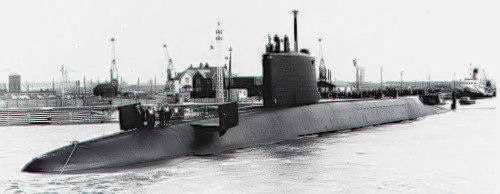 Barrow's second Polaris Sub - Repulse
Barrow's second Polaris Sub - RepulseThe programme was authorised in February 1963; the submarines were to be built in pairs, with maximum speed, by Vickers (Lead Yard) and Cammell Laird. The order for a fifth SSBN was announced in 1964, but was cancelled by a new Government the following year. The keel of the first of class, HMS Resolution, was laid down at Barrow on 26th February, 1964, and represented for Vickers the sternest test the yard had had for many a year.
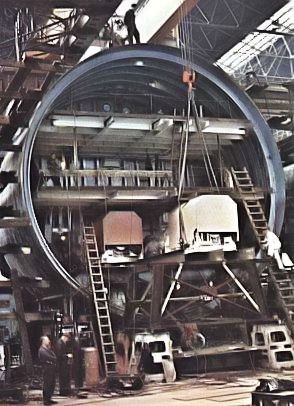 A Resolution unit under construction in the Assembly Shed
A Resolution unit under construction in the Assembly ShedThe planning and design effort which went into the Polaris submarine programme was colossal 500 000 man-hours of planning, preparation of more than 10 000 carefully detailed drawings all to be translated into the physical business of construction. Additionally, a full-scale wooden 'mock-up' was built. Not only did this allow the exact positioning of any piece of equipment to be planned and the routes for cables, pipes and trunking to be decided, but when the crew arrived to stand by their ship, they were able to train on the mock-up and become familiar with their new charge before they even set foot aboard her.
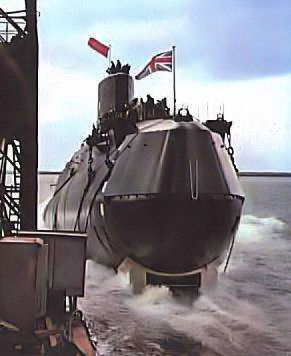 Resolution launch
Resolution launchIn constructing Resolution, the hull was assembled on the berth from sections prefabricated in the Assembly Shop. The fore and aft parts of the ship were built up simultaneously, and into the space between were placed the prefabricated missile sections, complete with missile tubes. Thirty months was the time occupied from keel laying to launch - which was carried out by Her Majesty Queen Elizabeth, The Queen Mother, on 15th September 1966.
The autumn of 1967 was an important one in the history of Vickers. Resolution, having successfully completed her Contractors' Sea Trials, was accepted into the Fleet on 2nd October.
To provide an operational submarine of completely new design, with a complete weapon system from the United States and with adequate support facilities, within 4½ years of ordering the vessel, was a truly remarkable performance. Vickers' workforce had met their challenge!
Hard on the heels of Resolution's delivery to the Fleet came the launch of Repulse, on 4th November. This launch was not accomplished without one of those heart pounding incidents which sometimes accompany these occasions. Repulse decided to elude the waiting tugs and remain on display in the Walney Channel until the next high tide.
Repulse was fitted-out in Devonshire Dock, and joined the Fleet, ahead of time, on 28th September, 1968. Her sister ships, Renown and Revenge, built at Cammell Laird, were commissioned in November 1968 and December 1969, respectively.
All on Target
 |
One of the most important events in the work-up of a Polaris submarine was the Demonstration and Shakedown Operation (DASO), which was conducted off Cape Kennedy in Florida. This operation culminated in the firing of a Polaris missile down the US Air Force Eastern Test Range to a target up to 2500 nautical miles away. The Ministry of Defence planned, in 1963, to fire Britain's first Polaris missile at 11.15 Eastern Standard Time on 15th February 1968 - HMS Resolution failed to achieve this by 15 milliseconds, but the firing was otherwise fully successful!
The firing of HMS Resolution's second Polaris A-3 on April 3rd 1968 |
Vigilance Maintained
|
Being the United Kingdom's contribution to NATOs strategic nuclear deterrent, at least one Polaris submarine was constantly on patrol, sailing submerged 'one knows not where', but always carrying her deadly 'cargo' of two-stage ballistic missiles. 'Sherwood Forest' was the nickname given to the compartment housing these 16 missiles, which were 31 feet long, 4½ feet in diameter and weighed 28,000 pounds. Fired from the submerged submarine, the multiple nuclear warheads could soar into the stratosphere and devastate a target 2,500 nautical miles away. One Polaris submarine carried more destructive potential than the total amount of explosives expended by all sides in the Second World War. When a Polaris submarine headed out into the open sea, the crew settled down to a life of routine, where days passed relatively quickly, but time seemed to stand still. Their main activities were devoted entirely to ensuring that the secrecy of their position was preserved, and that the deadly missiles were always ready to fulfil their ultimate purpose. To make the fullest use of Polaris submarines, each had two crews - known as Port and Starboard - which took turn and turnabout in the two-month patrol cycle. Food assumes an importance beyond its intrinsic value, and plays a large part in influencing the morale of those onboard. From the small galley of a Polaris submarine, three cooked meals a day were prepared for the 143 officers and men - in an eight-week patrol, the equivalent of feeding a family of four for five years. The primary source of power for Polaris submarines was a pressurised water nuclear reactor, which provided steam for the propulsion turbines and turbo-generators. Systems for everyday running range from high and low voltage electrical power, steam, hydraulic, pneumatic, lubricating oil and water for essential ship's services, to freshwater, air-conditioning and refrigeration for domestic purposes. A network of communications and control systems is used for the transmission of information, for direction of remote services, and for round-the-clock monitoring of conditions throughout the ship. |

 |
The Cost of Peace
Polaris submarines were designed to carry, and maintain in a state of readiness to fire, 16 Type A-3 Polaris missiles in addition to their conventional torpedo armament. The Admiralty believe that if the missiles were ever employed they will have failed in their purpose of preventing war. But to quote Vice-Admiral Sir Hugh Mackenzie (ex Chief Polaris Executive): 'It is no use pretending to be able to do the job. The stakes are too high to rely on bluff.
Such was the fearsome capability of HMS's Resolution, Renown, Repulse and Revenge that, even in peacetime, the 'opposition' was extremely unlikely to subscribe to that proverbial saying 'Out of sight, out of mind'.
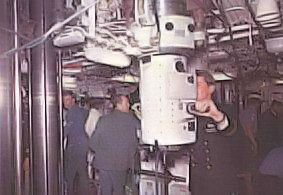 |
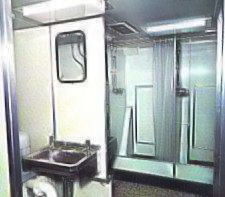 |
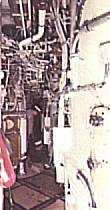 |
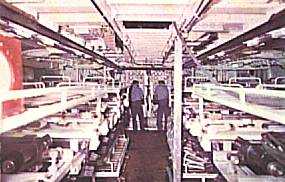 |
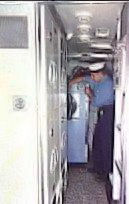 |
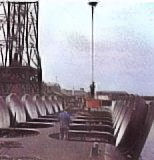 |
Some of the above information was kindly donated by the Barrow-in-Furness Submarine Association. You can visit their site here.

